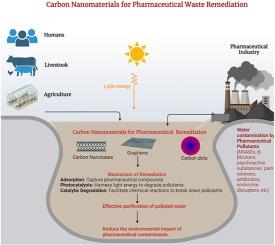Carbon nanomaterials for emerging contaminant remediation: Addressing pharmaceutical pollution in the water cycle with precision
IF 8.7
Q1 Environmental Science
引用次数: 0
Abstract
Carbon nanomaterials (CNMs), including carbon nanotubes (CNTs), graphene, and carbon dots (CDs), have emerged as promising solutions for pharmaceutical waste remediation in aquatic environments. CNMs outperform traditional adsorbents such as activated carbon owing to their high surface area, strong adsorption capabilities, and enhanced reactivity, making them effective in capturing and degrading a wide range of pharmaceutical pollutants. CNTs exhibit exceptional adsorption capacities owing to their porous structure and high surface area, whereas graphene and its derivatives offer enhanced adsorption and catalytic properties. CDs, owing to their excellent water solubility and tunable surface functionalities, have shown potential for both the adsorption and photocatalytic degradation of pharmaceutical contaminants. The synthesis methods for CNMs, including chemical vapor deposition, hydrothermal synthesis, and laser ablation, can be tailored to produce materials with specific characteristics that enhance their performance in pharmaceutical waste remediation. Numerous studies have demonstrated the efficacy of CNMs in removing various pharmaceutical compounds from aqueous solutions, such as antibiotics, anti-inflammatory drugs, and hormones, with superior performance compared to conventional adsorbents, such as activated carbon. However, challenges such as potential nanotoxicity, environmental persistence, and high production costs need to be addressed for the widespread application of CNMs in water treatment. Future research should focus on developing biodegradable and less toxic CNMs, improving synthesis and functionalization techniques for cost-effectiveness, and enhancing the stability and regeneration of CNM-based systems.

用于新兴污染物修复的碳纳米材料:精确解决水循环中的药物污染
碳纳米材料(CNMs),包括碳纳米管(CNTs)、石墨烯和碳点(CDs),已成为水生环境中药物废物修复的有前途的解决方案。CNMs由于其高表面积、强吸附能力和增强的反应活性而优于活性炭等传统吸附剂,使其能够有效地捕获和降解各种药物污染物。碳纳米管由于其多孔结构和高表面积而表现出优异的吸附能力,而石墨烯及其衍生物则具有增强的吸附和催化性能。CDs由于其优异的水溶性和可调节的表面功能,已显示出对药物污染物的吸附和光催化降解的潜力。cnm的合成方法,包括化学气相沉积、水热合成和激光烧蚀,可以定制出具有特定特性的材料,以增强其在制药废物修复中的性能。许多研究已经证明cnm在去除水溶液中的各种药物化合物(如抗生素、消炎药和激素)方面的功效,与传统的吸附剂(如活性炭)相比,cnm具有优越的性能。然而,cnm在水处理中的广泛应用需要解决潜在的纳米毒性、环境持久性和高生产成本等挑战。未来的研究应侧重于开发可生物降解和低毒性的cnm,改进合成和功能化技术以提高成本效益,并提高基于cnm的系统的稳定性和再生能力。
本文章由计算机程序翻译,如有差异,请以英文原文为准。
求助全文
约1分钟内获得全文
求助全文
来源期刊

Water Cycle
Engineering-Engineering (miscellaneous)
CiteScore
9.20
自引率
0.00%
发文量
20
审稿时长
45 days
 求助内容:
求助内容: 应助结果提醒方式:
应助结果提醒方式:


